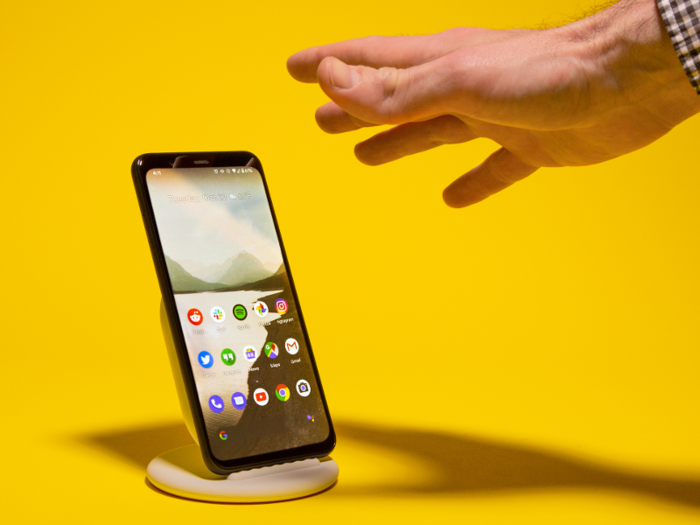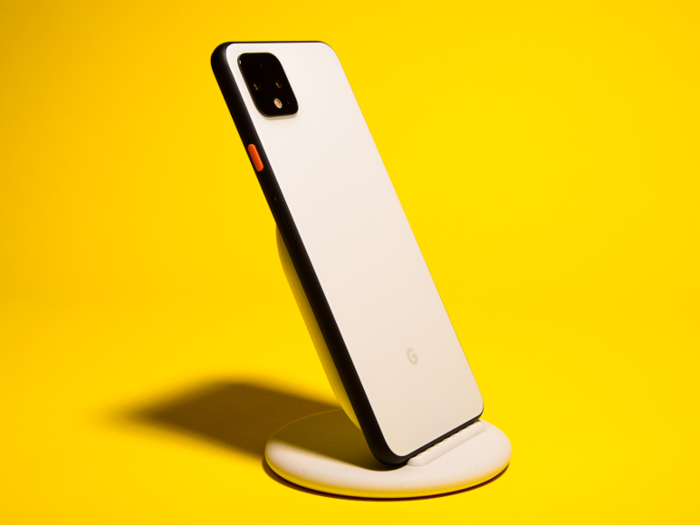- Home
- slideshows
- miscellaneous
- Google's new Pixel 4 is a solid phone, but it's not worth $800
Google's new Pixel 4 is a solid phone, but it's not worth $800
The Pixel 4's design is unimpressive, but that's because it's useful.
The Pixel 4's unimpressive design enables radar-powered features like Motion Sense that makes unlocking the Pixel 4 the best unlocking experience on a smartphone so far.
Motion Sense uses the Pixel 4's radar-powered smarts to track hand movements above the phone. So far, you can wave your hands around to skip back and forth through songs in music apps, snooze alarms, and silence an incoming phone call. It even detects when you're reaching for the Pixel 4 to prepare its facial recognition for a faster unlocking experience.
The Pixel 4 has mostly been a dream to unlock as a result of Motion Sense. It senses my hand approaching and starts the unlocking process, and by the time I have the phone in front of me, it's usually unlocked and ready to go.
The Pixel 4's facial recognition isn't actually as quick as the Pixel 3's fingerprint sensor. But it's still fast, automatic, nearly flawless, and requires no finger-reaching or any other specific motion to unlock the phone. It's almost feels as if I don't have any security set up, or even a lock screen.
Other radar-based Motion Sense features are cool, while some are a bit gimmicky and unreliable.

A small yet surprisingly good and useful Motion Sense feature is swiping your hand above the Pixel 4 to snooze an alarm — no looking at the screen to make sure you tap the right button. Plus, Motion Sense can tell when your hand approaches the phone and reduces your alarm's volume, too. This may seem inconsequential while you're reading this wide-awake, but it feels like a pretty great feature in the mornings, let me tell you.
Apart from that, the only other Motion Sense feature so far allows you to switch to the next track, which can be cool but gimmicky, and doesn't always work well. Otherwise, that's about all you can do with the gesture controls on the Pixel 4 so far. It's pretty limited, and you can already do a lot with your voice and Google Assistant, including switching to the next track.
It would be great to swipe your hand up or down to change the volume, for example. Or maybe use different finger gestures to navigate around the entire Android operating system and apps.
It's something that Google will surely improve over time, and I'd bet money that more comprehensive controls will someday come to the Pixel 4 or future Pixel phones. It's a pretty safe bet, as Google has already said that Motion Sense at the Pixel 4's launch is just the start.
Overall, Motion Sense is good because it's starting off slowly with just a few little features and functions. It's not overpromising anything, and it seems to have the best chance out of any other company's attempts to make motion gestures a "thing."
As expected, the Pixel 4's camera is phenomenal. But I get the sense that other phones have caught up dramatically, especially the iPhone 11.
Wherever you are, whatever you do, Pixel phones just seem to take a great photo that you'll be happy with, and the same goes for the Pixel 4. Not a lot of other smartphones offer that kind of confidence.
The irony is that there's a ton of Google's software and processing magic going on in each photo, but the Pixel 4 photos tend to look the least processed and more true-to-life than photos from most other smartphone cameras.
I still have to compare the Pixel 4 with other recent phones, especially the iPhone 11. From what I've heard, Apple has caught up in a big way to Google's Pixel cameras.
The new telephoto zoomed lens, combined with Google's software smarts, makes for the best zoomed smartphone camera performance — but it's nothing to write home about.

Google added a 2X optically zoomed lens to the Pixel 4, and as a result, you get great 2X zoomed photos. But Google has seemed proud of what the Pixel 4's zoomed lens can do when you zoom further than 2X, where the phone starts using software-based digital zooming.
Indeed, the Pixel 4's digital zooming is better than what I've seen on other phones, but photos with digital zoom still look like photos with digital zoom — there's still some blotchiness and detail smoothing. I wouldn't use the Pixel 4's digital zooming to capture anything meaningful.
It's unfortunate that the Pixel 4 doesn't have an ultra-wide lens, and you don't get the free, unlimited Google Photos storage for "original quality" photos anymore.
Could you image wider Pixel-quality photos that captures more scenery, colors, and details? Unfortunately, imagining how good ultra-wide Pixel 4 photos would look like is all we can do, since the Pixel 4 doesn't have an ultra-wide camera.
It's a shame that the Pixel 4 doesn't have an ultra-wide lens like some of its biggest competitors — it means the Pixel 4 is a less versatile smartphone for taking photos than other recent smartphones, like the iPhone 11, Galaxy S10, and OnePlus 7T.
Adding salt to the ultra-wide wound, Pixel 4 owners don't get the free, unlimited Google Photos storage at the "original quality" setting anymore, like Pixel owners did up until the Pixel 4. With the Pixel 4, you get free, unlimited storage at Google Photo's "high quality" option, which is still great. It's actually hard to tell the difference between "original" and "high quality," but still, it's a demotion.
The new astrophotography feature seems to work well, but you have to be under the right night sky to take amazing photos.

The astrophotography mode on the Pixel 4 captured the night sky amazingly well. At the same time, my night sky is a little boring, and I'd imagine most night skies are pretty boring, too.
I think you need to be at a location that's directly under the Milky Way, or somewhere that's absolutely pitch black with no noise pollution, to take photos that look good and interesting. Otherwise, astrophotos, at least mine, look somewhat boring.
If it's so utilitarian and truly wanted to be helpful, Google would have kept the headphone jack, or at least included a pair of wired USB-C earbuds.

No one should have expected Google to reintroduce a headphone jack into the Pixel 4 after ditching it with the Pixel 2. Nowadays, removing the headphone jack is pretty much standard, and I can't accuse Google of being unhelpful for this.
However, not including any audio solution at all — like a USB-C headphone dongle or even a pair of USB-C wired earbuds — with the Pixel 4 is unhelpful. If you have a traditional pair of wired headphones and you unbox the Pixel 4, you will not have anything you need to listen to music on your new Pixel 4.
The company surely wants you to buy its wireless audio solution to listen to music on the Pixel 4 — the Pixel Buds 2. But get this: they're not even coming out until next year. So either you're stuck with buying the extremely poorly reviewed original Pixel Buds, Google's USB-C wired earbuds, or your own choice of wireless Bluetooth headphones.
The Pixel 4 has had great performance during the week or so I've been using it.
The combination of a Qualcomm Snapdragon 855, 6 GB of RAM, and an adaptive 90Hz screen makes for a fast, smooth, and responsive experience that definitively makes the Pixel 4 a premium device. So far, there have been no issues worth reporting.
The adaptive 90Hz screen contributes a great deal to the Pixel 4's overall impression as a fast and powerful smartphone. It's purely aesthetic yet surprisingly noticeable and meaningful compared to 60Hz phone screens, like the iPhone 11 series and Galaxy S10.
For reference, the more "Hz" a screen has, the more frames per second it can display. More frames per second means smoother animations.
The Pixel 4's battery life isn't among the best I've seen on smartphones.
The 3,700mAh battery in the Pixel 4 will see you through the day, but not as comfortably as other smartphones. It's fine, but you'll find better battery life on an iPhone, Samsung Galaxy, LG, or OnePlus phone.
With that in mind, it would have been good to see some of the faster 25W-plus charging technologies we've seen in Samsung and OnePlus phones instead of the 18W charger that comes with the Pixel 4. That way, should the Pixel 4's battery life start to cause concern, a quick charge would help settle some nerves.
The 18W charges quickly — faster than the 5W charger that Apple continues to supply with the $700 iPhone 11 — but the point is that we're seeing better elsewhere.
Should you buy the Pixel 4? Sure, consider it. But take a good, long look at the competition, too.
The Pixel 4's $800 starting price isn't too exorbitant compared to other similar smartphones like the $700 iPhone 11 and $750 Galaxy S10e, but it's still hard to pinpoint exactly what about the Pixel 4 demands a higher starting price.
- It's not the design.
- It's not camera versatility.
- It's not the battery life.
- It's not Google Assistant, because all Android phones come with Google Assistant.
- It's definitely not the comparatively low base 64 GB of storage when other phones start with at least 128 GB (and if they do start with 64 GB, they're cheaper).
- You're not getting the unlimited photo storage at "original" quality in Google Photos, like you did the the Pixel 3 that cost the same as the Pixel 4 at launch.
- You're not getting USB-C wired earbuds or even a dongle.
- You're not getting anything special for charging.
- Other, even cheaper, phones also have great performance and great screens.
- The $700 iPhone has similar facial recognition technology, minus the radar-based Motion Sense stuff.
Is it the radar, then? With the seamless unlocking and swiping away the brutal morning alarm? Or perhaps it's getting Android updates as soon as they roll out? Maybe the 90Hz screen? It's up to you whether that stuff makes up for some of the shortcomings on the Pixel 4.
If you ran into me on the street and asked me my honest opinion, this is what I'd tell you:
I don't mind the design, I can live with the mediocre battery life, I have my own Bluetooth headphones already, and I barely store anything on my phones as everything is in the cloud, so the 64 GB base storage isn't an issue. The supreme performance of the Pixel 4's camera helps make up for the lack of an ultra-wide lens, but it still stings. I do really like the Motion Sense stuff, as it's helpful in small, meaningful ways. I'd say, sure, consider it. But take a good, long look at the $600 OnePlus 7T first.
Popular Right Now
Popular Keywords
Advertisement